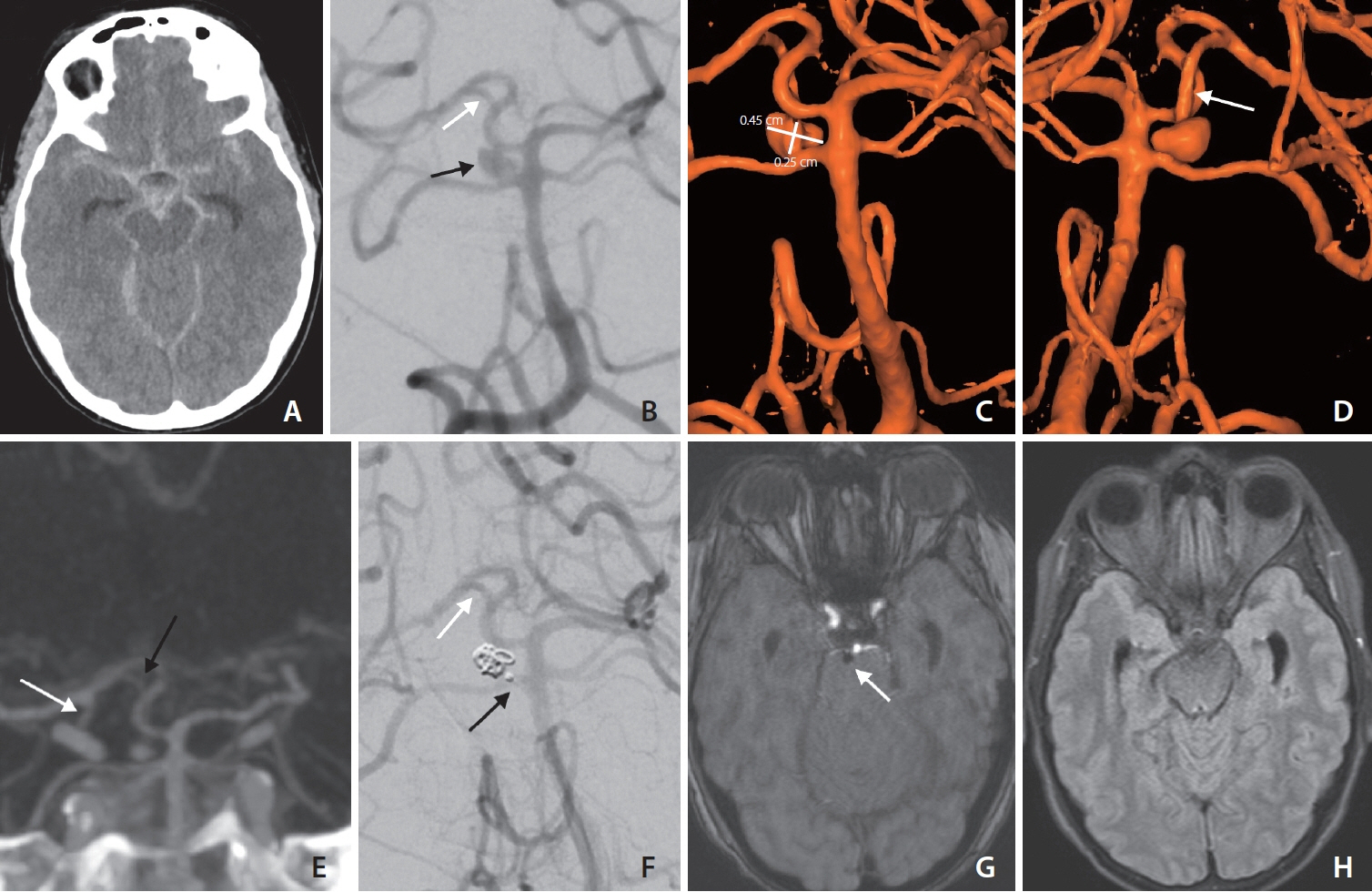Neurointervention.
2023 Mar;18(1):63-66. 10.5469/neuroint.2022.00486.
Novel Superior Cerebellar Artery Aneurysm Coming from a Superior Cerebellar Artery-Posterior Cerebral Artery Anastomotic Branch
- Affiliations
-
- 1Department of Neurosurgery, Baylor Scott and White Health, Temple, TX, USA
- KMID: 2539948
- DOI: http://doi.org/10.5469/neuroint.2022.00486
Abstract
- A middle-aged patient presented with subarachnoid hemorrhage and was found to have a ruptured superior cerebellar artery (SCA) aneurysm arising from the origin of a rare anastomotic branch between the right SCA and right posterior cerebral artery (PCA). The aneurysm was secured by transradial coil embolization, and the patient made a good functional recovery. This case demonstrates an aneurysm arising from an anastomotic branch between the SCA and PCA, which may represent a remnant of a persistent primordial hindbrain channel. Although variations in basilar artery branches are common, aneurysms rarely can form at the site of seldom- seen anastomoses between the branches of the posterior circulation. The complex embryology of these vessels, which includes anastomoses and the involution of primitive arteries, may have contributed to the development of this aneurysm arising from an SCA-PCA anastomotic branch.
Keyword
Figure
Reference
-
1. Korja M, Kivisaari R, Rezai Jahromi B, Lehto H. Size and location of ruptured intracranial aneurysms: consecutive series of 1993 hospital-admitted patients. J Neurosurg. 2017; 127:748–753.
Article2. Lasjaunias P, Berenstein A, ter Brugge KG. Surgical neuroangiography. 2nd ed. Springer;2001.3. Aydın ME, Kaya AH, Kopuz C, Demir MT, Corumlu U, Dagcinar A. Bilateral origin of superior cerebellar arteries from the posterior cerebral arteries, and clues to its embryologic basis. Anat Cell Biol. 2011; 44:164–167.
Article4. Caruso G, Vincentelli F, Rabehanta P, Giudicelli G, Grisoli F. Anomalies of the P1 segment of the posterior cerebral artery: early bifurcation or duplication, fenestration, common trunk with the superior cerebellar artery. Acta Neurochir (Wien). 1991; 109:66–71.
Article5. Gregg L, Gailloud P. The role of the primitive lateral basilovertebral anastomosis of padget in variations of the vertebrobasilar arterial system. Anat Rec (Hoboken). 2017; 300:2025–2038.
Article6. Ota T, Dofuku S, Sato M. Persistence of primitive lateral basilovertebral anastomosis with a ruptured posterior inferior cerebellar artery aneurysm: a case report. NMC Case Rep J. 2022; 9:69–72.
Article7. Tanaka M, Kikuchi Y, Ouchi T. Neuroradiological analysis of 23 cases of basilar artery fenestration based on 2280 cases of MR angiographies. Interv Neuroradiol. 2006; 12(Suppl 1):39–44.
Article8. Klostranec JM, Krings T. Cerebral neurovascular embryology, anatomic variations, and congenital brain arteriovenous lesions. J Neurointerv Surg. 2022; 14:910–919.
Article9. Menshawi K, Mohr JP, Gutierrez J. A functional perspective on the embryology and anatomy of the cerebral blood supply. J Stroke. 2015; 17:144–158.
Article10. Rhoton AL Jr. Aneurysms. Neurosurgery. 2002; 51(4 Suppl):S121–S158.
Article
- Full Text Links
- Actions
-
Cited
- CITED
-
- Close
- Share
- Similar articles
-
- Bilateral origin of superior cerebellar arteries from the posterior cerebral arteries, and clues to its embryologic basis
- Successful Endovascular Treatment of Ruptured Superior Cerebellar Artery Aneurysm Associated with Moyamoya Disease : A Case Report and Review of the Literature
- A Case of Aneurysm Arising from the Marginal Branch of Superior Cerebellar Artery: A Case Report
- Intracranial Aneurysm Associated with Aplasia of the Internal Cartoid Artery
- Coil Embolization of Ruptured Thrombosed Distal Superior Cerebellar Artery Aneurysm: A Case Report


